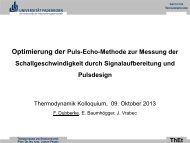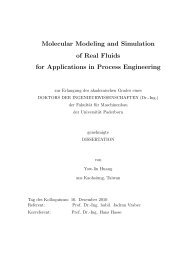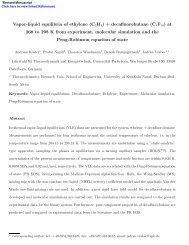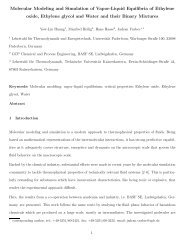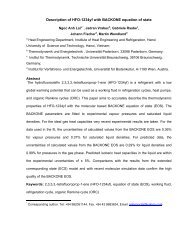ms2: A Molecular Simulation Tool for Thermodynamic Properties
ms2: A Molecular Simulation Tool for Thermodynamic Properties
ms2: A Molecular Simulation Tool for Thermodynamic Properties
You also want an ePaper? Increase the reach of your titles
YUMPU automatically turns print PDFs into web optimized ePapers that Google loves.
3.3.6. Transport properties<br />
In <strong>ms2</strong>, transport properties are calculated using equilibrium MD. Here, the fluctuations of a system around<br />
its equilibrium state are evaluated as a function of time. The Green-Kubo <strong>for</strong>malism relates these microscopic<br />
fluctuations to the respective transport properties.<br />
Diffusion coefficients. The self-diffusion coefficient Di is related to the mass flux of single molecules within a<br />
fluid. There<strong>for</strong>e, the relevant Green-Kubo expression is based on the individual molecule velocity autocorrelation<br />
function [44]. Since all molecules contribute to the self-diffusion coefficient, the autocorrelation function is<br />
averaged over all Ni molecules of component i in the ensemble to achieve better statistics. In binary mixtures,<br />
the Maxwell-Stefan diffusion coefficient − Dij is defined by [45]<br />
−Dij = xj<br />
Λii +<br />
xi<br />
xi<br />
Λjj −Λij −Λji , (8)<br />
xj<br />
wherexi = Ni/N andΛij can be written in terms of the center of mass velocity<br />
Λij = 1<br />
3N<br />
∞<br />
0<br />
Ni<br />
Nj <br />
dt 〈 vi,k(0)· vj,l(t)〉 . (9)<br />
k=1<br />
From the expressions above, the collective character of the Maxwell-Stefan diffusion coefficient is evident. This<br />
leads to significantly less data <strong>for</strong> a given system size and time step and there<strong>for</strong>e to larger statistical uncertainties<br />
than in case of the self-diffusion coefficient. Note that equations <strong>for</strong> the Maxwell-Stefan diffusion coefficient are<br />
implemented in <strong>ms2</strong> both <strong>for</strong> binary and ternary mixtures [45].<br />
Shear viscosity. The shear viscosityη, as defined by Newton’s ”law” of viscosity, is a measure of the resistance<br />
of a fluid to a shearing <strong>for</strong>ce [46]. It is associated with the momentum transport under the influence of velocity<br />
gradients. Hence, the shear viscosity can be related to the time autocorrelation function of the off-diagonal<br />
elements of the stress tensor Jp [44]<br />
η = 1<br />
VkBT<br />
∞<br />
Averaging over all three independent elements of the stress tensor, i.e. J xy<br />
p ,Jxz<br />
0<br />
l=1<br />
dt J xy<br />
p (t)·J xy<br />
p (0) . (10)<br />
p andJyz p , improves the statistics.<br />
The componentJ xy<br />
p of the microscopic stress tensor Jp is given in terms of the molecular positions and velocities<br />
by [46]<br />
<br />
J xy<br />
N−1<br />
p =<br />
i=1<br />
mv x i v y<br />
i −<br />
N−1 <br />
N<br />
n<br />
n<br />
i=1 j=i+1 k=1 l=1<br />
r x ij<br />
∂uij<br />
∂r y . (11)<br />
kl<br />
Here, the lower indicesl andk indicate theninteraction sites of a molecule and the upper indicesxandy denote<br />
the spatial vector components, e.g. <strong>for</strong> velocityvx i or site-site distancerx ij . The first term of Eq. (11) is the kinetic<br />
energy contribution and the second term is the potential energy contribution to the shear viscosity. Consequently,<br />
the Green-Kubo integral (10) can be decomposed into three parts, i.e. the solely kinetic energy contribution, the<br />
solely potential energy contribution and the mixed kinetic-potential energy contribution [46].<br />
11



